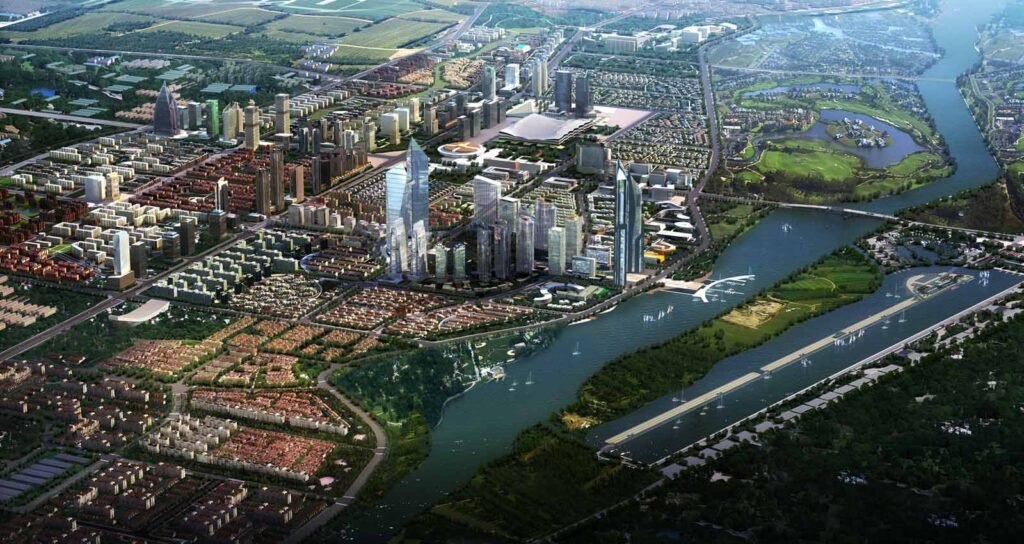Sustainable Energy Solutions: Powering a Greener Future.
Introduction.
1. Solar Energy Harnessing Sun’s Power Sustainable Energy Solutions Of Lahore Smart City.

Solar power, a form of renewable energy, has been widely used for many years. It involves capturing solar energy and converting it to electricity or heat. Photovoltaic systems (PVs) and solar thermal systems are responsible for generating solar power.
Photovoltaic Systems:
These systems directly convert sunlight into electrical energy using solar panels made from semiconductor materials. As technology improves, the efficiency of PV systems increases, making them a more attractive option for commercial, residential, and utility-scale applications.
Solar Thermal Systems:
This technology utilizes lenses or mirrors to concentrate sunlight and produce heat, which can then be used to generate electricity through steam turbines or other means. Solar thermal systems are capable of generating large amounts of electricity.
2. Wind Power Energy from the Air.
Harnessing wind kinetic energy to produce electricity is known as wind energy. Wind turbines facilitate this process by converting wind energy into mechanical and electrical energy.
In recent years, large-scale wind farms have proliferated worldwide. Offshore wind farms, situated on bodies of water, hold significant potential due to their consistent wind patterns and reduced visual impact.
Wind energy has a low carbon footprint and is sustainable. However, it poses certain challenges, including the need for suitable locations, potential impacts on bat and bird populations, and intermittent production. Nonetheless, wind energy remains a major player in the transition from fossil fuels to sustainable energy sources.
3. Hydropower Water as a Source of Energy.
Hydropower is a reliable and traditional form of renewable power that generates electricity by using falling or flowing water. The most common way to achieve this is by installing turbines on rivers or building dams.
These include the negative environmental impacts of dam construction, the displacement of local communities, and changes to ecosystems.is still a major contributor to renewable energy sources worldwide, despite these concerns.
4. Biomass energy renewable organic matter.
The biomass energy process involves using organic materials such as wood, crop wastes, or animal waste to generate energy. This process can include combustion, anaerobic digestion, or gasification to produce electricity, heat, or biofuels.
Biomass energy utilizes organic materials that can replenish over time. Sustainability relies on responsible sourcing, avoiding deforestation, and other harmful practices. Using biomass energy reduces landfill waste and provides a way to reuse waste materials.
Although biomass energy has a lot of potential, it must be managed carefully to remain a sustainable solution.
5. Geothermal energy heat from the earth.
Geothermal energy harnesses the heat produced by the Earth’s core to generate electricity or direct heating. This energy source finds application in various fields, including heating buildings and powering geothermal power stations.
As a renewable source with a small carbon footprint, geothermal energy can provide base-load energy, delivering consistent energy all day long, unlike other renewable sources.
However, its utilization is limited to regions with suitable geological conditions such as hot springs or volcanic activity. Nonetheless, it remains a very valuable part of the energy landscape.
The conclusion of the article is.
The way to a more resilient and greener future. This transition involves key components such as solar power, wind, hydropower, and biomass energy, each with its advantages and challenges. Embracing a variety of renewable energy sources and investing in research and technology can help reduce our dependence on fossil fuels.
An integrated approach to sustainable energy benefits not only the environment but also economic growth, social well-being, and energy security. As technology improves and renewable energy becomes more readily available, the prospects of a sustainable future are increasing. This offers hope for a healthier and cleaner planet.
0 Comments